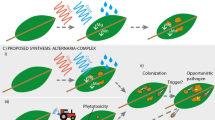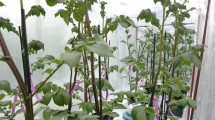Abstract
The effect ofAlternaria alternata on gas exchange proceses, on total yield and on yield components in cottonGossypium hirsutum cv. Acala SJ-2, was examined under field conditions. Variations in disease severity levels were achieved by using three fungicide treatments (Fentin Acetate). Disease developed more rapidly on the upper canopy layer (>661 cm height) than on lower ones. Infections were not accompanied by leaf shedding. The main effect of the disease was a reduction on bolls' number. A significant increase in seedcotton and lint yield, as compared to the untreated control, was achieved by applying fungicides. It was found that omitting early and late applications was not followed by significant yield reduction. Alternaria leaf spot reduced photosynthetic rate more and transpiration rate less, than could be explained by the extent of infected leaf area alone.
Samenvatting
Het effect vanAlternaria alternata op fotosynthese en transpiratie, opbrengstcomponenten en totale opbrengst bij katoen (Gossypium hirsutum L.) werd onderzocht onder veldomstandigheden. Verschillen in aantastingsniveaus werden verkregen door fungicide (fentin acetaat) behandelingen. De ziekte ontwikkelde zich het snelst boven in het gewas (> 60 cm). Infectie ging niet gepaard met bladval. Het belangrijkste effect van de ziekte vormde een afname van het aantal vruchtdozen (‘bolls’). Een significante toename van zaadkatoen (‘seedcottton’) en van vezels (‘lint’) ten opzichte van de onbehandelde controle werd verkregen door toediening van fungiciden. Achterwege laten van vroege en late bestrijdingen had geen significante opbrenstverlaging tot gevolg.A. alternata verlaagde de fotosynthesesnelheid meer en de transpiratiesnelheid minder dan verklaard kon worden uit de geïnfecteerde oppervlakte van het blad.
Similar content being viewed by others
References
Ayres, P.G. & Jones, P., 1975. Increased transpiration and the accumulation of root absorbed86Rb in barely leaves infected byRhynchosporium secalis (leaf blotch). Physiological Plant Pathology 7:49–58.
Bashan, Y., 1986. Phenols in cotton seedlings resistant and susceptible toAlternaria macrospora. Journal of Phytopathology 116:1–10.
Bashi, E., Kimchi, M., Sachs, Y. & Blikle, V., 1983a., Alternaria leafspot in cotton: epidemiology and control. In: A Cohen (Ed.), Proceedings of cotton research. Ministry of Agriculture, Israel. pp. 173–176 [in Hebrew].
Bashi, E., Rotem, J., Pinnschmidt, H. & Kranz, J., 1983b. Influence of controlled environment and age on development ofAlternaria macrospora and on shedding of leaves in cotton. Phytopathology 73:1145–1147.
Bashi, E., Sachs, Y. & Rotem, J., 1983c. Relationship between disease and yield in cotton fields affected byAlternaria macrospora. Phytoparasitica 11:89–97.
Boote, K.K., Jones, J.W., Smerage, G.H., Barfield, C.S., & Berger, R.D. 1980. Photosynthesis of peanut canopies as affected by leafspot and artificial defoliation. Agronomy Journal 72: 247–252.
Constable, G.A., & Rawson, H.M., 1980. Carbon production and utilization in cotton: Inferences from carbon budget. Australian Journal of Plant Physiology 7:535–553.
Droby, S., Dinoor, A., Prusky, D. & Barkai-Golan, R., 1984. Pathogenicity ofAlternaria alternata on potato in Israel. Phytopathology 74:535–542.
Duniway, J.M. & Durbin, R.D., 1971. Some effects ofUromyces phaseoli on the transpiration rate and stomatal response of bean leaves. Phytopathology 61:114–119.
Ellis, M.B. & Holliday, B.P. 1970.Alternaria macrospora No. 246., In: Description of Pathogenic Fungi and Bacteria. Commonwealth Mycological Institue., Kew England.
James, W.C., 1974. Assessment of plant diseases and losses. Annual Review of Phytopathology 12:27–48.
Janardhanam, K.K. & Husain A., 1983. Studies on isolation, purification and identification of tenmayonic acid, a phytotoxin produced byAlternaria alternata (Fr.) Keisler, causing leaf blight ofDatura innoxia Mill. Mycopathologia 83:135–140.
LI-COR, Inc., 1983. LI-6000 portable photosynthesis system. Instruction manual. LI-COR Inc., 4421 Superior St., P.O. Box 4425, Lincoln Nebraska, 68504, USA.
Park, P., Nishimura, S., Hohamoto, K. & Otani, H., 1981. Comparative effect of host specific toxin from four pathotypes ofAlternaria alternata on the ultrastructure of host cells. Annals of the Phytopathological Society of Japan 47:488–500.
Patel, J.C., Patel S.K. & Patel, A.J., 1985. Efficiency of certain systemic and non-systemic fungicides in control of Alternaria leaf spot on cotton. Indian Journal of Mycology and Plant Pathology 13:227–228.
Plaut, J.L. & Berger, R.D., 1980. Development ofCercosporidium personatum in three peanut canopy layers. Peanut Science 7:46–49.
Rabbinge, R., Jorritsma, I.T. & Schans, J. 1985. Damage components of mildew in winter wheat. Netherland Journal of Plant Pathology 91:235–247.
Rotem, J., Sachs, Y. & Drefer, V., 1982. Alternaria leafsport in cotton cv. Pima: epidemiology and control. In: Cohen, A. (Ed.), Proceedings of cotton research. Ministry of Agriculture, Israel. p. 155–156 [in Hebrew].
Rotem, J., Wendt, V. & Kranz, J., 1988a. The effect of sunlight on symptoms ofAlternaria alternata on cotton. Plant Pathology 37:12–15.
Rotem, J., Eidt, J., Wendt, V. & Kranz, J., 1988b. Relative effects ofAlternaria alternata andA. macrospora on cotton crops in Israel. Plant Pathology 37:16–19.
Singh, M., Narain, V. & Singh, M., 1985. Leafspot of deshi cotton caused byAltenaria alternata. Indian Journal of Mycology and Plant Pathology 14:171.
Turner, N.C., Hearn, A.B., Begg, J.E. & Constable, G.A., 1986. Cotton (Gossypium hirsutum L.): Physiological and morphological responses to water deficits and their relationship to yield. Field Crops Research 14:153–170.
Youssif, R.A., El-Safty, N.A. & El-Sawah, M.Y.., 1977. Effect of different fungicide formulationsin vitro on spore germination ofAlternaria tenuis Nees, the causal incidence of cotton leafspot in Egypt. Agricultural Research Review 55:73–77.
Watkins, G.M., 1981. Alternaria leafspot. In: Watkins, G.M. (Ed.), Compendium of cotton diseases. The American Phytopathological Society. p. 28.
Author information
Authors and Affiliations
Rights and permissions
About this article
Cite this article
Ephrath, J.E., Shteinberg, D., Drieshpoun, J. et al. Alternaria alternata in cotton (Gossypium hirsutum) cv. Acala: Effects on gas exchange, yield components and yield accumulation. Netherlands Journal of Plant Pathology 95, 157–166 (1989). https://doi.org/10.1007/BF01999971
Accepted:
Issue Date:
DOI: https://doi.org/10.1007/BF01999971




